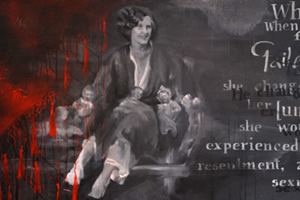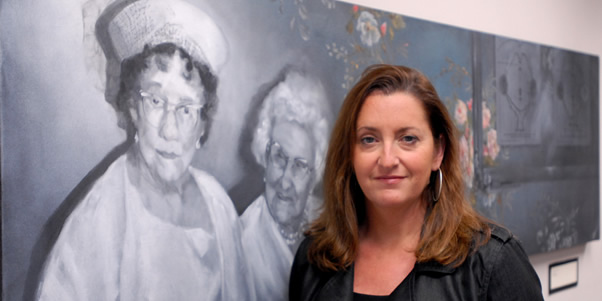Questioning Gender
Professor’s Paintings Focus on Women, Power, Technology
January 27, 2009
By Mimi Ko Cruz
Through her paintings, Karyl E. Ketchum, assistant professor of women’s studies, wants you to question the nature of gender and power.

This is a piece of Ketchum's "Clarabell Meets Sigmund," mixed media on canvas. Photo by Kelly Lacefield
Complex in form and content, her artwork is being featured in Room 211 of the Humanities-Social Sciences Building, the office of the dean of the College of Humanities and Social Sciences. On display through June are four of Ketchum’s paintings from a 10-piece series -- each on a 2-foot-by-8-foot canvas.
“The pieces included in this exhibition explore the construction of gender ranging from Freud and his surprisingly tenacious assertions regarding female sexuality; to assumptions regarding femininity, the body and aging; to vision and masculinity; and to a piece inspired by feminist philosopher Julia Kristeva’s assertion that women exist only symbolically,” Ketchum said.
She began creating the images in 2004. Her artist’s statement describes her paintings as “formal -- including their odd shape and pastiche of highly disparate visual elements."
“I first became fascinated with Formalism through poetry and the Formalist Literary Movement’s inquiry into the qualities that define a text as properly ‘poetic,’ signaling to the reader a change in registers of meaning and, thereby, coaxing into that semiotic modality, which might be equated to the theater’s requisite suspension of disbelief,” Ketchum said in her statement.

This is Ketchum's "Women's Time: The Monumental, The Cyclical, and Kristeva," oil on canvas. Photo by Kelly Lacefield
Ketchum received her doctorate and master's in cultural studies and her bachelor's degree in art studio from UC Davis. She joined Cal State Fullerton’s faculty in 2006. Her research interests include feminist theory, technologies, visual culture, cultural studies, semiotics and structuralist, post-structuralist theories of language.
She recently answered the following questions for Inside.
Where are the other six paintings in this series?
The other pieces stand in various stages of completion: some partially painted or printed onto canvas, some merely rough sketches, some fragments in my computer. I hope to have these all completed and ready for exhibition in about a year. ... There is no beginning image or first canvas -- no guideposts indicating where one is to begin to spin off meanings. Rather, my viewer must determine the point from which meaning begins.
How long have you been an artist?
I have been drawing, painting and ‘making stuff’ for as long as I can remember. However, this in and of itself is not what I feel makes me an artist. To my mind, artists are those individuals with an ability to see the world from multiple vantage points. They have what might be understood as an innate capacity to think critically and, by way of this, the rest of us -- artist and non-artist alike -- are given an opportunity to understand the world anew.
Many of the really creative people I know live in what might be somewhat humorously described as a kind of parallel universe: seeing relative relationships where others see certainty; establishing ideological points of reference through intuition, experience and emotion rather than custom, tradition or doctrine; and, more often than not, highly skeptical of ‘truth.’ Their identities and varied contributions as artists seem to begin within this experience. So, my definition of, and identity as, an artist is perhaps broader in reach than the historical or popular one. This is a good thing.
How and why did you create these pieces?
The four images in the current show were conceived and executed in constant conversation with my computer. I experimented with type face in the computer, changed parts of images to black and white, and sampled and experimented with visual fragments on my computer’s screen before executing these on the canvas.
While all of the compositions are technology-dependent in various ways, only one of the pieces included here is overwhelmingly so. The piece entitled ‘Interpellation’ is a digital image printed directly onto canvas, which I then went back into minimally with oil paint. In the final showing of this work -- the complete statement of all 10 canvases -- there will be other pieces that incorporate digital printing processes with oil paint to varying degrees and in both obvious and subtle ways.
I like to imagine my viewer studying each piece for traces of the ‘inauthenticity’ of the digital printing process; maybe even questioning why I would ‘cheat’ in this way when, judging by the other pieces, I obviously can paint.
One goal of my work is to question, ‘what is art?'
Finally, I would be remiss if I did not discuss the obviously feminist orientation of the work. Gender, as a social construction, appears to be rather a simple and obvious sort of thing. One is, or is not, a particular gender. Once again, simplicity is a function of the habitual as the more we delve into the assumptions, affects and exigencies of gender, the more it begins to reveal itself as complex and complicit with power in all its various contemporary and historical forms. I hope my viewers will be provoked and perhaps even a bit disturbed and that, through this, they might begin to question the nature of gender and power themselves.
How do you use art in your lectures?
In the class I regularly teach, ‘Gendered Technoculture,’ we create and interrogate images in Photoshop, extend ourselves virtually in Second Life, construct experimental video projects, and re-imagine the Internet through designing websites as art, activism and cultural critique. We also read some of the most fascinating current work on gender, power and technology.
A Decade of Art in Humanities
Ketchum’s work is the latest in a long series of artists featured in the dean’s office and conference room for more than a decade, Dean Thomas P. Klammer said.
“We’ve had paintings — oil, watercolor, and mixed media — drawings, photographs, quilts and even sculpture,” he said. “The artists we have featured include both faculty and community members. Not only does the art enliven our workplace, but it turns our office and conference room into a place for art education, often challenging the viewers to expand their horizons of appreciation. I think Karyl’s paintings do that very effectively. She provokes her viewers both artistically and intellectually. Her paintings are aesthetic objects, but they are also rich in content. They invite analysis and argumentation.”

This piece, "Interpellation," is a digital image printed directly onto canvas, which Ketchum minimally touched up with oil paint. Photo by Kelly Lacefield
Related Story:
Biologist Finds Art Through Pain


